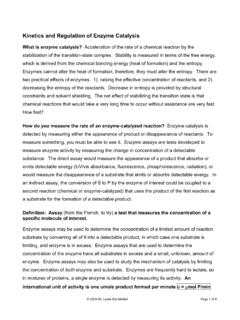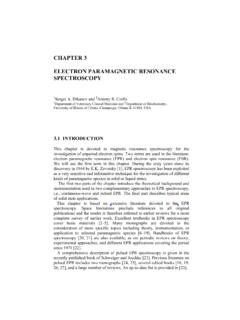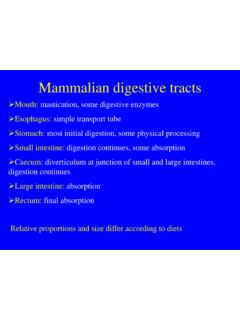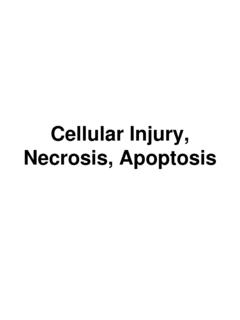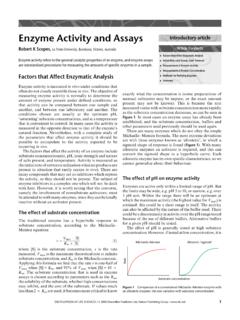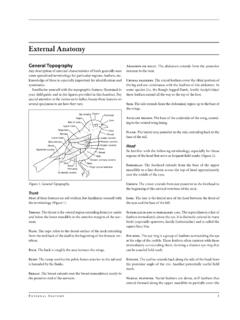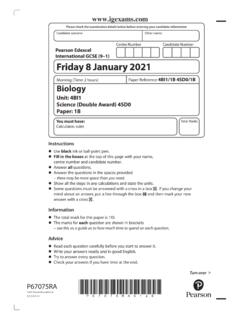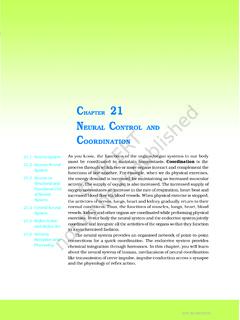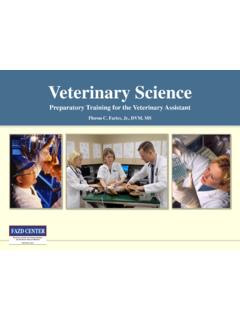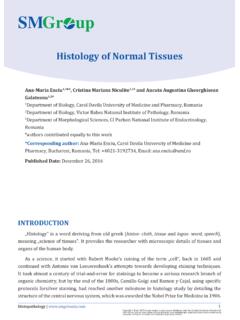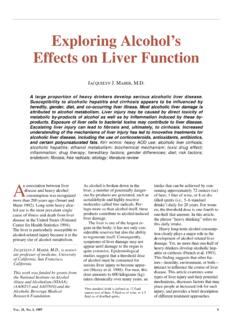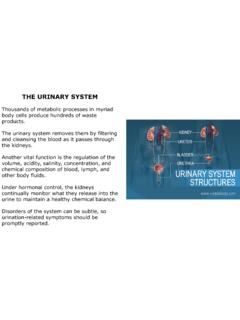Transcription of An Introduction to Anatomy & Physiology
1 2012 Pearson Education, Inc. PowerPoint Lecture Presentations prepared by Jason LaPres Lone Star College North Harris 1 An Introduction to Anatomy & Physiology NOTE: Presentations extensively modi6ied for use in MCB 244 & 246 at the University of Illinois by Drs. Kwast & Brown (2013- 2014) 2012 Pearson Education, Inc. Chapter 1 Learning Objectives Describe the basic functions of organisms. Define Anatomy & Physiology and the various specialties of each. Identify and understand the major levels of organization of our bodies. Identify and describe the 11 organ systems of the body.
2 Understand and be able to explain the concept of homeostasis and describe the roles of negative and positive feedback in regulating body functions. Identify the major body cavities using proper anatomical terms. 2012 Pearson Education, Inc. Anatomy & Physiology : The study of structure -function relationships in biology Anatomy Describes the structures of the body including What they are made of Where they are located Associated structures Physiology Is the study of the function of biological systems including, of course, anatomical structures It includes both individual and cooperative functions Anatomy & Physiology : forms the foundation for understanding the body s parts and functions in concert.
3 2012 Pearson Education, Inc. Introduction A Brief History of Anatomy Anatomy (anatome = to cut up): study of cutting up of the structural parts Oldest medical science; cadaver dissection (dis = apart; secare = to cut) Egypt: Anatomical or Edwin Smith Surgical Papyrus (1600 BCE): Contains 48 case histories of medical trauma and their treatment; describes closing wounds with sutures, preventing and curing infection with honey, stopping bleeding with raw meat as well as immobilizing the head and neck to prevent spinal cord injuries during transport. Also contain the first known descriptions of the cranial sutures, meninges, external surface of the brain, cerebrospinal fluid, and intracranial pulsations.
4 Also basic Anatomy of major organs and blood vessels as well as use of plants for treating medical conditions. Greece: Hippocrates (5th & 4th century BCE) Greek physician/medical scientist Aristotle (4th century BCE) text based in animal dissections: arteries, veins, organs and organ systems Herophilos & Erasistratus (4th century BCE) extensive cadaver dissections 2012 Pearson Education, Inc. Introduction A Brief History of Anatomy Greece Cont.: Herophilos & Erasistratus even performed vivisections on criminals! Claudius Galenus ( Galen of Pergamon (Turkey)--2nd century BCE) compiled previous knowledge and filled in gaps with animal ( , monkey & pig) dissections ( Ancient World s Gray s Anatomy [1500 years]) physician to Roman Emperors Renaissance (1500s) Andreas Vesalius ( De humani corporis fabrica On the workings of the human body) founder of modern human Anatomy Gallows (Roman 14th 16th BCE) & Graves (Michelangelo 17th 18th century) Galileo charged admission for traveling cadaver dissections Anatomy Act of 1832 (UK)
5 Finally provided for an adequate legal supply of cadavers for medicine (lead to Gray s Anatomy ) [Murder Act of 1752 --stipulated that only the bodies of convicted murderers were allowed for legal dissection] What about recent advances? Are there any or has it all been done? .. 2012 Pearson Education, Inc. Introduction Modern Anatomical Projects 2012 Pearson Education, Inc. Introduction Human Anatomy as Art? Body Worlds , Bodies , etc. = traveling exhibitions of preserved human bodies prepared using a technique called plastination (German anatomist Gunther von Hagens - water and fat replaced by acetone then plastics [silicone rubber, polyester & epoxy resins] up to 12 month process); have done animals as large as horses.
6 Controversial: Who are these people and were they willing participants? Also debate over Texas inmate used in Visible Human Project Finally, there continue to be advances in paleopathology, showing evolution of the human form (not only from distant relatives but of modern humans height) 2012 Pearson Education, Inc. Introduction Human Physiology Physiology comes from Ancient Greek: physis, "nature, origin"; and -logia, "study of". Anatomy & Physiology together is the study of structure -function relationships in biological systems Human Physiology is the study of the mechanical, physical, and biochemical functions of humans, their organs, and the cells of which they are composed.
7 Physiology includes: Biochemistry, Biophysics, Cell Biology & Chemistry, Endocrinology, Genetics, Genomics, Immunology, Kinesiology, Neurobiology, Pathology, etc. 2012 Pearson Education, Inc. Introduction Brief History of Human Physiology Human Physiology dates back to the time of Hippocrates father of modern medicine (5th century BCE) Claudius Galenus [ Galen of Pergamon] (c. 126-199 ) used experiments to probe body functions; the founder of experimental Physiology . Middle Ages the Muslim physician Avicenna (980-1037) introduced experimentation and quantification in The Canon of Medicine. Ibn al-Nafis (1213 1288) first physician to correctly describe the Anatomy of the heart, the coronary circulation, the structure of the lungs, and the pulmonary circulation Renaissance (1500s) Andreas Vesalius (De humani corporis fabrica) founder of modern human Anatomy Herman Boerhaave (Leiden 1708) father of clinical Physiology textbook Institutiones medicae 2012 Pearson Education, Inc.
8 Introduction Brief History of Human Physiology 19th century Cell theory of Schleiden & Schwann, which radically stated that organisms are made up of units called cells. Claude Bernard's (1813 1878) concept of milieu interieur (internal environment), which would later be taken up and championed as "homeostasis" by American physiologist Walter Cannon (1871 1945) 20th century comparative Physiology and ecophysiology (Knut Schmidt-Nielsen and George Bartholomew). Most recently, evolutionary Physiology has become a distinct subdiscipline. Recent advances are in the Systems Biology subdisciplines, such as physiological genomics (functional genomics) In addition, advances in cell Physiology / biology can be expected for decades (centuries?)
9 Physiology IS at the center of systems biology and, indeed, personalized medicine. 2012 Pearson Education, Inc. 1-4 Relationships between Anatomy & Physiology Anatomy Gross Anatomy , or macroscopic Anatomy , examines large, visible structures Surface Anatomy : exterior features Regional Anatomy : body areas Systemic Anatomy : organ systems Developmental Anatomy : from conception to death Clinical Anatomy : medical specialties 2012 Pearson Education, Inc. Anatomy microscopic Anatomy examines cells and molecules Cytology: study of cells and their structures cyt- = cell Histology: study hist- = tissue 1-4 Relationships between Anatomy & Physiology 2012 Pearson Education, Inc.
10 Physiology Subdisciplines Cell Physiology : processes within and between cells Organ Physiology : functions of specific organs Systemic Physiology : functions of an organ system Pathological Physiology : effects of diseases 1-4 Relationships between Anatomy & Physiology 2012 Pearson Education, Inc. 1-5 Levels of Organization Chemical (or Molecular) Chemical, Mechanical and Electrical events that occur within and between cells Cellular The fundamental compartments of all known living organisms and the molecules and organelles within working together Tissue Group of cells working together in a concerted manner Organ A group of tissues working together to perform specific functions Organ System An organ system is a group of organs working together Humans have 11 organ systems Organism A human is an organism 2012 Pearson Education, Inc.

